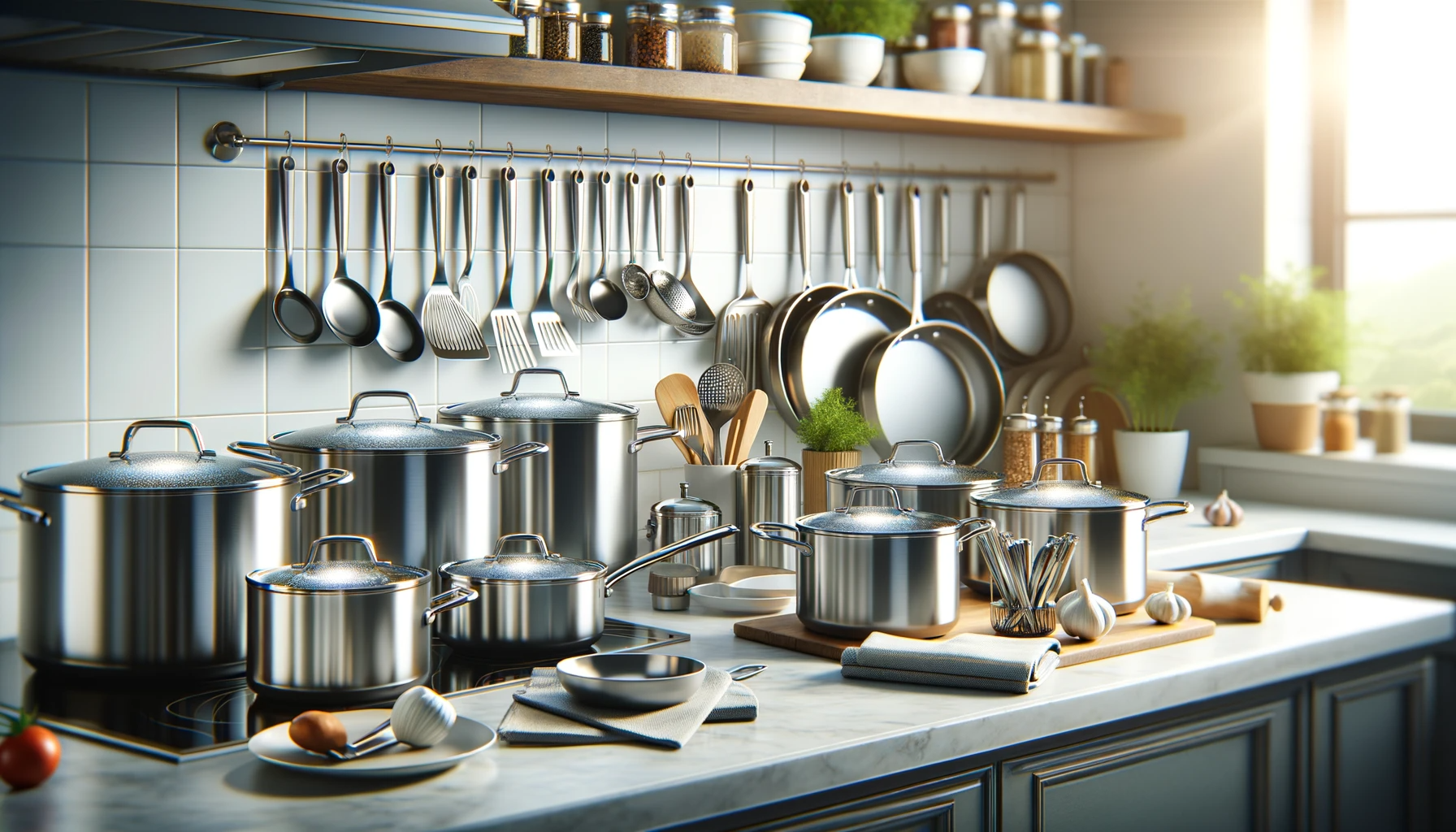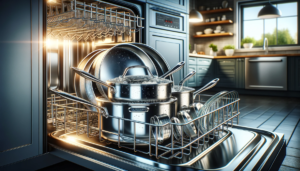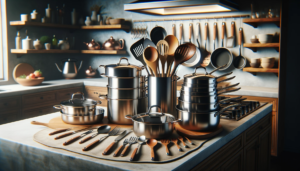With all the concerns over Teflon and other chemicals in pots and pans these days, many home cooks wonder, is stainless steel cookware actually safe for my family?
Stainless steel cookware poses little risk for most people when used properly, but sensitivities to metals like nickel should still be considered when cooking for long periods.
Let’s dive into the grades of stainless steels used in cookware, potential health impacts, proper use and care, plus safer brands and alternatives to be aware of.
What is Stainless Steel Cookware?
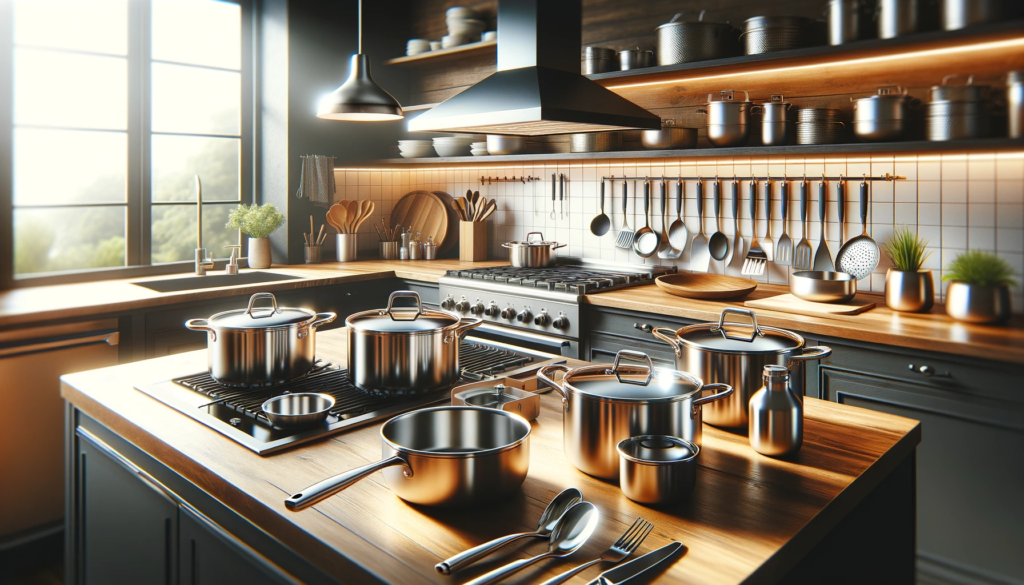
Stainless steel cookware refers to pots, pans, and other cooking vessels such as stock pots, sauce pans, skillets, and baking sheets that are made from stainless steel metal.
Stainless steel itself is a steel alloy, meaning it is a mixture of iron with other elements like chromium, nickel, molybdenum, and sometimes copper added in.
There are many different grades and types of stainless steel out there depending on the exact composition, but cookware is most commonly made from the 300 series grades.
Specific alloys in the 300 series, especially 304 and 316 stainless steel, have high enough levels of chromium and nickel to make them resistant to corrosion and rusting.
The chromium content helps form a passive oxide layer on the surface of the stainless steel cookware that resists staining, pitting, and rust formation.
Nickel also enhances corrosion resistance while providing durability and ease of fabrication.
The exact percentages of metals like chromium and nickel differ between alloys, impacting properties like hardness, weldability, and conductivity.
But for cookware purposes, the 300 series hits the sweet spot of being durable yet still affordable for consumer use.
Is Stainless Steel Food Safe?
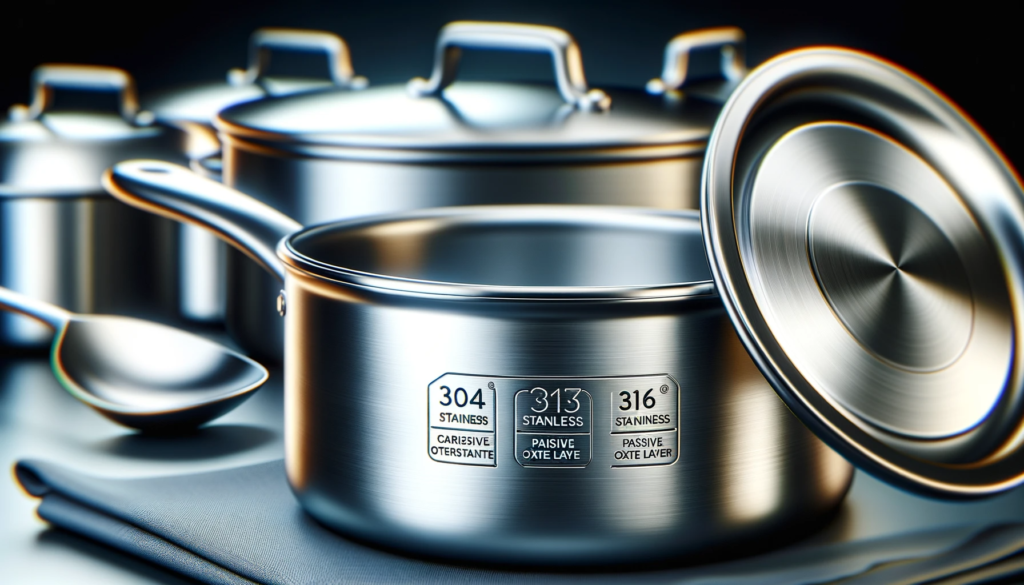
The FDA has extensive regulations and guidance regarding metals, chemical coatings, paints, and base materials that come into contact with food during cooking.
Metals like chromium, nickel, iron, and manganese are all monitored and regulated with set limits determining quantities allowed to leach from cookware into foods during the cooking process before posing potential health risks.
Stainless steel pans, baking trays, and pots will leach very small, trace amounts of nickel and chromium when new out of the box, especially with repeated cooking of acidic ingredients.
However, FDA research and independent studies have shown that in most cookware, under typical household cooking conditions these stainless steel alloys release levels that stay well below the defined daily safety limits and maximum exposure recommendations, even over extended use.
There is an initial “conditioning” phase for new stainless steel cookware where a bit more leaching can occur, but then it tapers off and stabilizes after repeated use over the first few weeks to months.
The overall quantities of metals that enter food also depend on factors like cooking temperature, acidity levels of ingedients, quality of the stainless steel itself, how long food is cooked or stored in contact with the metal alloy, and whether the cookware surface becomes extensively scratched or eroded over long periods of time.
Health Concerns Around Stainless Steel Cookware
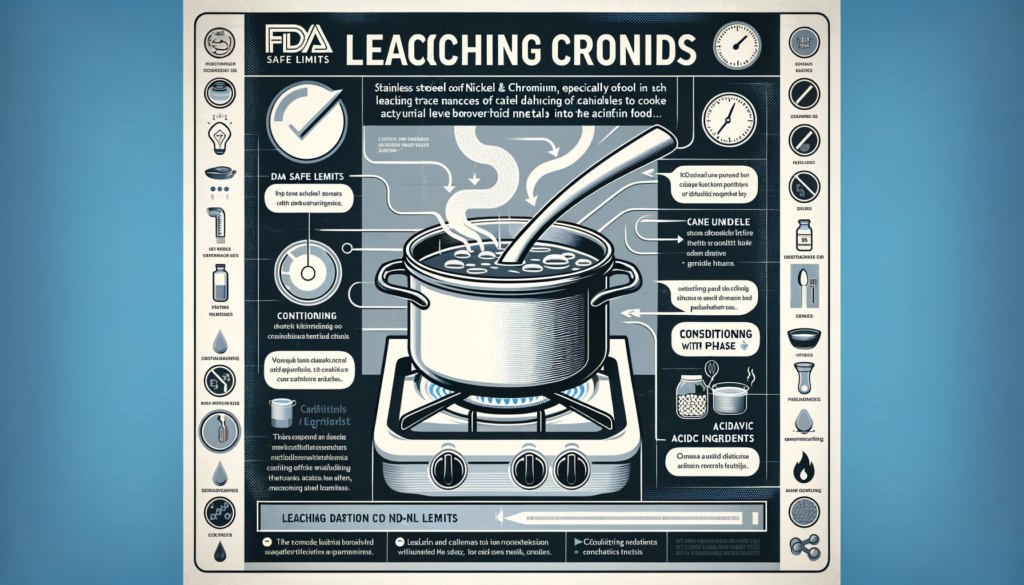
While deemed broadly food safe for most people under typical usage, some potential health concerns still exist regarding stainless steel pans.
Individuals who already exhibit sensitivies to certain metals may need to excercise more caution.
Nickel Leaching and Allergies
As mentioned above under food safety, stainless steel alloys do release trace amounts of nickel into acidic food cooked within them.
For those with nickel allergies or sensitivities, special care must be taken to minimize additional nickel exposure coming from cookware metal leaching.
Nickel allergies impact around 10-20% of people and lower doses exceeding around 0.2 mg can still be enough to trigger reactions in those with sensitivities when ingested during eating.
Reactions can range from minor skin irritation to increasing severity impacts like dermatitis or even systematic anaphylactic symptoms in sensitive individuals when enough is absorbed internally.
While high quality 300 series stainless steel stays substantially below this level during most conventional household cooking tasks, those with severe nickel allergies may still wish to limit exposure time by avoiding extended cook times for acidic items, limiting metal utensil use, or considering nickel-free stainless alternatives like 400 series options marketed to nickel-sensitive buyers.
Metal Leaching into Food
Similar to potential nickel exposure, cooking acidic or brine ingredients for long periods, especially when simmering or boiling, can cause more substantial leaching of metals over time from stainless steel cookware into the food being prepared.
Again this includes trace amounts of primary alloy metals like chromium and nickel.
Testing shows amounts typically still meet FDA guidance for safe limits regarding exposure from cookware.
But some especially sensitive individuals run higher risk of irritation or over-exposure reactions the longer acidic and high-heat cooking goes on.
Enameled steel, pure titanium, tempered glass, and coated ceramic pans provide non-reactive, metal-free cooking surfaces to combat this reactivity for those concerned with avoiding as much metal introduction as possible.
Using lower heats, shorter cook times, more oil/liquid, and deglazing pans helps minimize stainless steel’s metal leaching potential as well.
Overheating and Burns
As a relatively poor heat conductor itself, the risk of direct skin burns from grabbing an actively heated stainless steel pan or oven rack are lower compared to materials like pure aluminum or copper.
But once brought up to higher cooking or roasting temperatures, stainless steel equally retains that ambient heat level very efficiency as it starts cooling back down.
So appropriate precautions must still be taken to avoid inadvertent burns after your stainless steel cookware comes off the stove or out of a hot oven.
Pot holders, handles, and appropriate countertop resting spots are vital, as well as keeping pan handles safely pointed away from walkways whenever possible.
At extreme temperatures like broiling, the steel itself can take progressively longer to dissipate heat once removed from the direct heat source.
Additionally, while durable against kitchen usage, stainless steel cookware should never be exposed to temperatures drastically outside manufacturer specifications, either exceeding maximums or submitting pans to thermal shock by rapid cooling/heating swings.
Doing so risks metal warping or changes to the alloy integrity itself which accelerate wear and metal leaching over subsequent use.
Are Scratched Pans Dangerous?
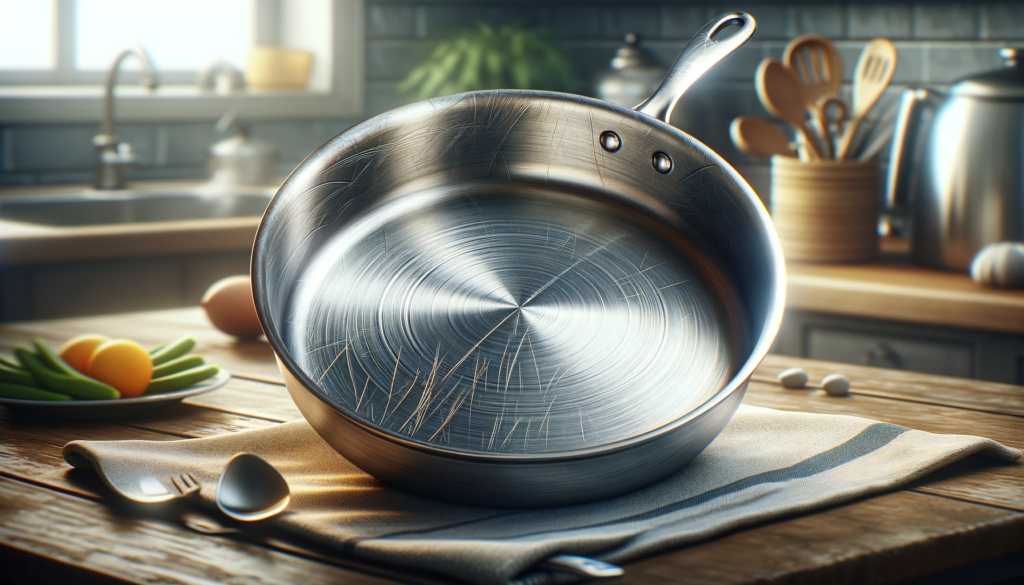
Minor scratching and wearing of a stainless steel pan or baking sheet surface itself does not inherently make cookware unsafe or dangerous to use in most instances.
But progressive wearing down and deeper scratches formed over repeated use can impact effectiveness, cooking performance, and contributes higher likelihood of metal leaching with continued use if not remedied.
Light surface scratches pose little increased risk and won’t make stainless steel cookware suddenly dangerous or unusable.
However, deep scratches and gouges that remove multiple outside layers of the stainless steel alloy material can allow notably increased direct metal leaching if occurring around areas that regularly contact food.
This leaching may spike initially but still often remains within defined safety limits for most people, especially if acidity and cook times are controlled like discussed earlier.
That said, if surface damage leads to full puncturing or holes that clearly expose the inner copper or aluminum core layer underneath the external stainless – such severely compromised cookware should be fully retired and replaced.
Not only will this lead to substantially uncontrolled metal introduction directly into food, but also rapid deterioration of the surrounding steel through corrosion, oxidation damage, and further pitting or crack formation near breach sites.
In daily use, gentle handling with proper utensils selected for stainless steel cookware will greatly minimize potential scratching or gouging damage right from the start.
Metal utensils or abrasive scours like steel wool should always be avoided.
Lightweight silicone or wood options are greatly preferred.
If light scratching still inevitably occurs over years of kitchen use, quickly reconditioning pans by scrubbing out any stuck on bits then giving the inside a protective wipedown rub with cooking oil until lightly smoking can guard against accelerated wear or corrosive issues taking hold.
How to Use and Maintain Stainless Steel Pans
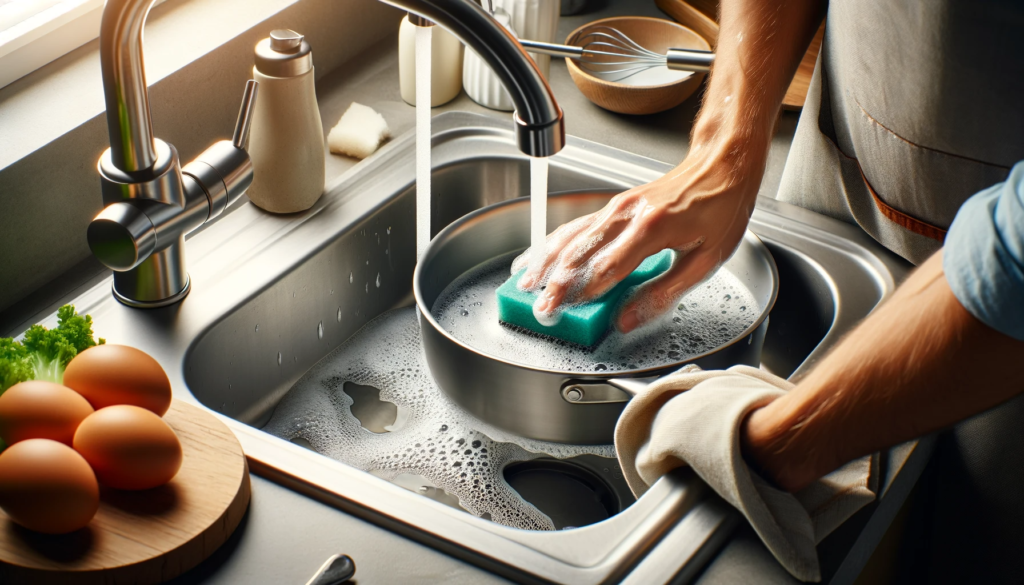
Caring properly for stainless steel cookware by following manufacturer’s usage and care guidance helps ensure ongoing safe usage while extending the working lifespan of pots, pans, and baking sheets significantly.
Ideally, stainless steel cookware should be handwashed gently after each use by an owner whenever possible rather than placing items in a harsh dishwasher cycle.
Even high quality stainless steel can degrade eventually under repeated dishwasher use.
For handwashing, fully rinse away all soap residue after cleaning, then immediately dry the stainless steel item thoroughly with a towel rather than air drying.
Allowing stainless surfaces to air dry risks temporary moisture damage or corrosion over longer-term use.
Before first use with food or whenever stubborn residues, stains, or stuck bits occur, use a mild paste of baking soda mixed with warm water to gently lift residue without abrasive rubbing.
Alternatively, soft plastic, silicone, or sponge scours are sufficient for cleaning stainless interiors when needed between oil seasoning touch ups.
If food bits do burn onto pan surfaces, immediately deglaze the stainless steel after cooking by boiling water or manufacturer recommended non-abrasive cleaners to lift charred deposits before they permanently adhere.
To keep stainless steel cookware performing at its best, occasionally recondition the inner cooking surface by wiping a micro-thin layer of high smoke point oil over it, then heating the pan until the oil lightly smokes to polymerize it onto the steel.
After fully cooling, any excess can be wiped away leaving an effectively nonstick transparent sheen behind.
Slight visible oil residue is normal.
Repeat oiling and reseasoning touchups every few weeks or months as needed when stainless interiors lose their slipperiness or when unhealthy fats oxidize.
Health Advantages of Stainless Steel Cookware

Commercial cooking grade stainless steel is valued so highly not only for its durability and longevity, but also because it is remarkably nonreactive for metal alloy cookware.
When used correctly for its intended cooking applications, bare stainless steel neither adds any metallic or chemical tastes to food nor poses substantial risks of base material contamination that could lead to flu-like metal fume fever or other dose-related reactions.
Uncoated 300 series stainless is medically and chemically inert enough for extensive use in hospital facilities and commercial kitchens around the world.
Compared to many consumer cookware lines that apply non-stick coatings, ceramic glazes, or painted enamel finishes which can degrade, discolor, or chip over repeated high heat exposure – quality stainless steel maintains its fundamental integrity and staying power essentially forever if properly maintained.
Its surface hardness resists wear while the corrosion resistant chromium oxide passive layer reforms itself naturally if surface damage does temporarily occur.
Stainless steel thereby contributes far less waste over decades of kitchen functionality compared to trendy finishes that fail after a few short years.
Upkeep is straightforward and new pans readily recycle old well-worn ones.
In choosing higher-grade stainless steel cookware wisely once rather than disposable models, owners invest in lifelong cookware that can be responsibly passed down between generations.
Such heirloom-level longevity honors stainless steel’s ultimate claim as perhaps the safest and most sustainable mainstream cookware foundation across any kitchen.
What Are the Safest Brands of Stainless Steel Cookware?
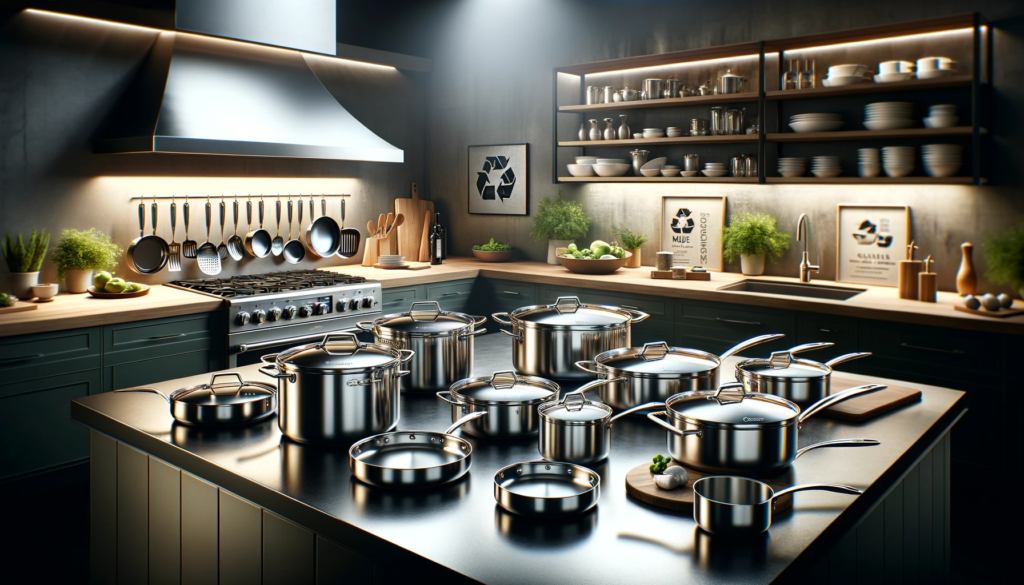
With countless cookware lines available from names both highly renowned and totally unfamiliar, it helps substantially to focus stainless steel buying decisions around well proven brands boasting extensive histories and reputations for quality, safety, and consumer transparency.
All-Clad consistently earns recognition across both professional chef communities and general home cooks for their bonded construction stainless-steel cookware which sandwiches highly conductive cores like aluminum or copper between durable, machined stainless steel outer layers.
Their meticulous attention to precise material sourcing, thickness standards, hardness benchmarks, machining tolerance specifications, layer bonding procedures, and smoothing/polishing steps yield Final products refined enough for the rigors of commercial kitchens while still accessible to discerning home buyers as well.
Other reputable stainless steel manufacturers like Cuisinart, Calphalon, and Made In also adhere to rigorous safety testing standards and remain involved through every step along their supply chains – providing confidence that only food-safe grades of metals are ultimately used across their stainless steel cookware product families.
Beyond shared commitments to ethical business practices and sustainability initiatives like recycling programs or charitable partnerships, these leading producers stand behind their cookware with strong limited lifetime warranties as added buyer protection.
When sourced mindfully from brands that prioritize quality, food-grade stainless steel cookware makes for worthy kitchen investments that should endure beautifully across decades of cooking use. And smaller specialist start ups focusing explicitly on non-toxic, ethically-conscious cookware design, like Heritage Steel Amsterdam, provide elevated modern options for those seeking the ultimate in conscientious stainless purchases.
What Are the Alternatives to Stainless Steel Pots and Pans?
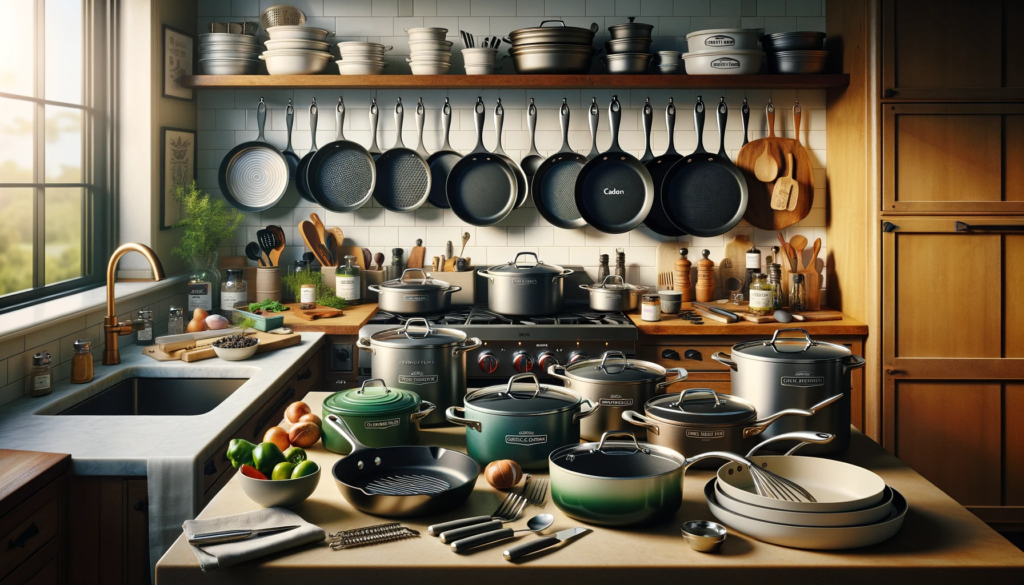
For all its strengths and cooking virtues, stainless steel properties inherently prevent the material from fitting every possible kitchen application on its own.
Compared to even more conductive metals like pure copper or aluminum, stainless steel conducts heat slower which increases preheating times and can create more uneven cooking layers especially with thicker stock pots or grill pans.
Without special seasoning as discussed above, stainless steel tends to stick with some ingredients unless more fat or liquid is used during cooking processes.
And the surface tends to show visible scratching more readily than darker material finishes can mask.
If these factors pose an issue for certain cooking preferences or recipes, several specialty cookware alternatives provide comparable safety to stainless steel while addressing some of its limitations.
Ceramic non-stick pans from GreenPan allow worry free release when sautéing delicate proteins or eggs without interacting with foods.
Unseasoned cast iron or carbon steel develops an almost glass-like nonstick finish over time with the right oil polymerization care.
Anodized aluminum like All-Clad’s D3 line rapidly conducts and distributes heat for perfect crispness and caramelization.
While no cookware option eliminates tradeoffs completely, pairing thoughtful stainless steel choices with supplemental pieces in materials like classic French enamel, German steel-cored ceramic, or heavy-based Cuisinart hard anodized aluminum allows enjoying the benefits of each where they excel individually.
And thoughtfully matching lids, handles, oven-proof capacities and finishes across a multi-piece collection creates cohesive everyday functionality.
Just be sure to follow all manufacturers’ safe usage instructions, hand wash gently, and avoid extreme thermal shock across any nonstick or specialty finishes selected as stainless steel complements.
Conclusion: Is Stainless Steel Ultimately Among the Safest Cookware Choices Available?
When selected discerningly around reputable specialty brands and product linesoptimized for food grade durability over cost-focused corners cut manufacturing, quality stainless steel absolutely ranks among the most fundamentally inert, stable, and thereby safest cookware foundation materials available for everything from searing sautés to simmering stews.
Assuming responsible usage avoiding excessive thermal damage, wear, or alteration to the essential composition itself, commercial series 300 stainless steel poses negligible health or contamination risks during anything approaching normal kitchen use, especially for individuals without unusual acute sensitivity to trace metals inherently present in some ingredients already.
Top stainless steel even mirrors medical and scientific instruments in its exemplary resistance to corrosion with only routine care needed perpetuating near pristine nonreactivity almost indefinitely.
For the staunchest home health advocates or those managing severe diagnosed metal allergies already however, limitations exist leaving stainless steel less than ideally tailored to every unique situation faced.
Minimizing acidic cook times helps reduce any metal leaching substantially while 400 series nickel-free stainless steel provides another excellent mass market option as well.
And supplementing workhorse stainless pans with specialty ceramic, enameled, or thoughtfully seasoned cast iron alternatives allows enjoying the benefits of nonreactivity exactly when called for in more occasional niche applications.
Frequently Asked Questions
What is the overall safest cookware for health?
Quality stainless steel rates among the safest and most inert mainstream cookware materials available, especially when used responsibly to avoid excessive metal leaching or overheating beyond advisable limits.
But vitreous ceramic, inert seasoned cast iron, medical-grade titanium, and specialist glass ovenware all minimize metal exposure as well.
Strictly considering potential cookware safety, uncoated stainless steel, vintage French enamel, medical titanium, German ceramic, and properly seasoned old-fashioned cast iron tend to rank among the most measurably non-reactive across various scientific studies when contamination risk is prioritized over all other factors.
But real world optimal safety extends far beyond laboratory conditions alone.
Ultimately the safest cookware for health depends enormously on many supporting factors beyond raw material safety ratings alone: Proper purchasing vetting cookware manufacturing processes and supply chains for dangerous contaminants, following all advised usage instructions every time, intelligent pairing with other pans in safer nonreactive materials when appropriate, always allowing adequate cleaning and drying care between all uses, avoiding extreme thermal stresses or scratch damage beyond reasonable wear, retiring heavily eroded cookware responsibly before metal leaching spikes, and fitting cookware durability/longevity to household cooking needs through high quality equipment selected purposefully over trendy disposable options.
Absolute cookware safety ranks as a holistic practice rather than any single perfect product recommendation alone.
What foods or ingredients should avoid being cooked in stainless steel?
Highly acidic ingredients like tomatoes, citrus juices, vinegars, wines, and preservative-heavy condiments have increased potential to react with and erode stainless steel surfaces through prolonged simmering or reduction processes.
Opting for shorter stainless steel cook times or prep in more nonreactive pans is preferable when working extensively with acidic items.
Some especially nickel-sensitive individuals or those managing systemic histamine regulation issues may also wish to moderate potential exposure by preparing allergy-trigger ingredients like soy, legumes, tree nuts, shellfish, chocolate, or problem nightshades in ceramic or enameled cookware instead as an added precaution.
What are the main disadvantages of stainless steel as a cookware material?
Stainless steel’s moderate thermal conductivity prevents quite as rapid or even heating compared to pure dense metals like copper or aluminum.
Pre-heating generally takes longer while also requiring more attention to temperature control once heated.
Without an optimal sheer slippery finish from machined surfaces or applied oil seasoning, stainless steel often necessitates extra fats or oil during cooking as well compared to some ceramic or enameled surfaces that release more easily when ingredients catch or stick.
While resistant against corrosion or rust, visible scratches, metal marks, or minor denting also show more obviously on brushed stainless steel exteriors because its gray tones don’t hide wear quite as effectively darker material finishes often can.
And compared to thinner mass-produced aluminum or ceramic designs prioritizing light weight, upper tier stainless steel cookware like All-Clad’s tri-ply tends to carry notably hefty bulk that makes handling unwieldy for some users based on strength or preferred cooking motions.
